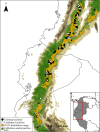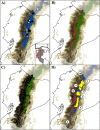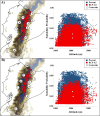Ecological and geographical analysis of the distribution of the mountain tapir (Tapirus pinchaque) in Ecuador: importance of protected areas in future scenarios of global warming
- PMID: 25798851
- PMCID: PMC4370470
- DOI: 10.1371/journal.pone.0121137
Ecological and geographical analysis of the distribution of the mountain tapir (Tapirus pinchaque) in Ecuador: importance of protected areas in future scenarios of global warming
Abstract
In Ecuador, Tapirus pinchaque is considered to be critically endangered. Although the species has been registered in several localities, its geographic distribution remains unclear, and the effects of climate change and current land uses on this species are largely unknown. We modeled the ecological niche of T. pinchaque using MaxEnt, in order to assess its potential adaptation to present and future climate change scenarios. We evaluated the effects of habitat loss due by current land use, the ecosystem availability and importance of Ecuadorian System of Protected Areas into the models. The model of environmental suitability estimated an extent of occurrence for species of 21,729 km2 in all of Ecuador, mainly occurring along the corridor of the eastern Ecuadorian Andes. A total of 10 Andean ecosystems encompassed ~98% of the area defined by the model, with herbaceous paramo, northeastern Andean montane evergreen forest and northeastern Andes upper montane evergreen forest being the most representative. When considering the effect of habitat loss, a significant reduction in model area (~17%) occurred, and the effect of climate change represented a net reduction up to 37.86%. However, the synergistic effect of both climate change and habitat loss, given current land use practices, could represent a greater risk in the short-term, leading to a net reduction of 19.90 to 44.65% in T. pinchaque's potential distribution. Even under such a scenarios, several Protected Areas harbor a portion (~36 to 48%) of the potential distribution defined by the models. However, the central and southern populations are highly threatened by habitat loss and climate change. Based on these results and due to the restricted home range of T. pinchaque, its preference for upland forests and paramos, and its small estimated population size in the Andes, we suggest to maintaining its current status as Critically Endangered in Ecuador.
Conflict of interest statement
Figures





References
-
- Roulin X (1829) Mémoire pour servir á l’histoire du tapir; et description d’une espéce nouvelle appartenant aux hautes régions de la Cordillére des Andes. Annales des Sciences Naturelle Zoologie Paris 17: 26–55.
-
- Lizcano D, Pizarro V, Cavelier J, Carmona J (2002) Geographic distribution and population size of the mountain tapir (Tapirus pinchaque) in Colombia. Journal of Biogeography 29: 7–15.
-
- Padilla M, Dowler RC, Dowler CC (2010) Tapirus pinchaque (Perissodactyla: Tapiridae). Mammalian species 42: 166–182.
-
- Schauenberg P (1969) Contribution à l'étude du Tapir pinchaque, Tapirus pinchaque Roulin 1829. Revue Suisse de zoologie 76: 211–256.
Publication types
MeSH terms
LinkOut - more resources
Full Text Sources
Other Literature Sources

